#wellington painters
Text
#painting#interior painting#painting service#wellington interior painting service#interior painters#wellington painters#interior painting company#interior painting service
1 note
·
View note
Text
ZR Decorating Services
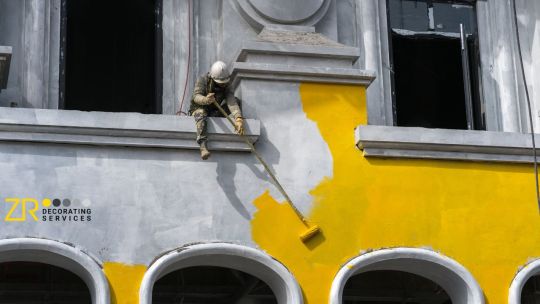
ZR Decorating Services is a premier provider of professional house painting services in Wellington. Our mission is to provide painting services at the highest standards at affordable prices! Efficient, Reliable, and high quality.
Visit Our Website
0 notes
Text
Interior Painters in Wellington: Transforming Spaces with Precision and Style
Transform your interiors with Viet Duc's expert interior painters in Wellington. Our skilled team ensures flawless finishes, bringing a touch of finesse to your living or working space. Trust us for craftsmanship that elevates the ambience of your property.
0 notes
Text
OOC: The Napoleonic Askblog/Roleplay Scene Directory
Here's an Out Of Character post listing the blogs I'm aware of in the Napoleonic RPF Roleplay Scene! It's OOC because Lannes would want to make sarcastic remarks with typos.
If you want (or don't want) your blog on this list, message me and whether you want a main/other blog associated with your name or whether you want to be anonymised! Also happy to include non-Frenchmen and Frev folks.
Doubles or multiple versions of people are welcome, this is a varied afterlife. We all have our different ideas for what this afterlife is like as well.
Feel free to reblog or link to this!
And now we have a OOC discord server to chat about all of this! Feel free to join if you'd like!
The Marshalate
armagnac-army - Jean Lannes, Duke of Montebello - played by @cadmusfly
murillo-enthusiast - Jean-de-Dieu Soult, Duke of Dalmatia, and ADCs - played by @cadmusfly
@le-brave-des-braves - Michel Ney, Prince of the Moskva, Duke of Elchingen, and ADCs - played by @neylo
@your-dandy-king - Joachim Murat, King of Naples - played by @phatburd
@chicksncash - André Masséna, Prince of Essling, Duke of Rivoli, and others - played by @chickenmadam also playing as his ADC, with appearances from Marshal Augereau, the Cuirassier Generals d'Hautpoul and Nansouty, and the Horse Grenadier General Lepic
@your-staff-wizard - Louis-Alexandre Berthier, Prince of Neuchâtel and Valangin, Prince of Wagram - played by @chickenmadam, as above
@perdicinae-observer - Louis-Nicolas Davout, Prince of Eckmühl, Duke of Auerstaedt - played by @mbenguin
@bow-and-talon - Laurent de Gouvion Saint-Cyr, Marquis of Gouvion-Saint-Cyr
@france-hater - Jean-Baptiste Bernadotte, or Charles XIV John of Sweden, played by @deathzgf
@simple-giant-ed - Édouard Mortier, Duke of Treviso, played by @isa-ko
The Grande Armée
@general-junot - Jean-Andoche Junot, Duke of Abrantes - played by @promises-of-paradise
@askgeraudduroc - Géraud Duroc, Duke of Frioul, Grand-Marshal of the Palace - played by @sillybumblebeegirl, also with cameos from Marshal Bessières shared with your-dandy-king
@trauma-and-truffles - Baron Dominique-Jean Larrey, Surgeon to Napoleon and the Imperial Guard - played by @hoppityhopster23 who also plays his modern assistant
@generaldesaix - Louis Charles Antoine Desaix de Veygoux, most likely would have been a marshal if he lived - played by @usergreenpixel
@messenger-of-the-battlefield - Marcellin Marbot, aide-de-camp of maréchal Lannes - played by @a-system-of-nerds
@le-dieu-mars - Jean-Baptiste Kleber, General - played by @chickenmadam
@puddinglesablonniere, Charles-Étienne César Gudin de La Sablonnière, Gemeral of Davout's Corps
@francoislejeunes, Baron Louis-François Lejeune, ADC to Berthier, Artist and Engineer
The Bonaparte Family
@carolinemurat - Caroline Murat née Buonaparte, Queen of Naples - played by @usergreenpixel
@alexanderfanboy - Napoleon Bonaparte, The Big Cheese
@frencheaglet - Napoleon II, also known as Franz, Duke of Reichstadt, played by @usergreenpixel
@rosie-of-beauharnais - Rose Beauharnais, also known as Josephine Bonaparte, once Empress of the French
@le-fils - Eugène Beauharnais, Prince of the Empire, Bonaparte's stepson, played by @josefavomjaaga
@jbonapartes - Jérôme Bonaparte, King of Westphalia, Prince of Montfort
@napoleon-bonapartee - Napoleon Bonaparte, The Head Honcho
Other Notable Personages
@askjackiedavid - Jacques Louis David, neoclassical painter - played by @sillybumblebeegirl
Not French
Russians
@the-blessed-emperor - Tsar Alexander I, the Blessed
@loyal-without-flattery - General Aleksey Andreevich Arakcheev, who runs His Imperial Majesty's Own Chancellery
@god-of-the-army - Prince Pyotr Ivanovich Bagration, played by @deathzgf
British
@wellingthighs - Arthur Wellesley, Duke of Wellington, played by @deathzgf
@the1ronduke - Arthur Wellesley, Duke of Wellington
Original Characters and Friends
@the-adventures-of-lydia-brown - Lydia Brown, a jack of all trades and problem solver finding herself in this strange realm with all these dead Frenchmen
Hopster, trauma-and-truffles's modern time travelling assistant
Madam DuQuay, ADC who takes no nonsense, helping out chicksncash, your-staff-wizard and le-dieu-mars
#napoleonic rpf#napoleonic roleplay scene#napoleonic roleplay#historical roleplay#historical rpf#out of character#organisational documents
57 notes
·
View notes
Text

Theory: Lake District/Cumbria, England = basis for Oletus manor, Lakeside, and Golden Cave?
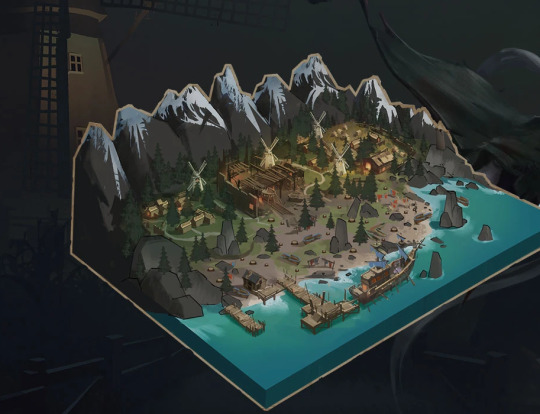
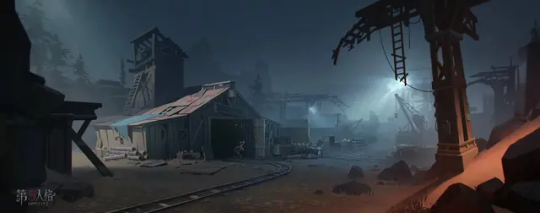

Lake District sits just below the Scottish border and includes England’s largest lake, Windermere, and tallest mountains, Scaffel
Pike.
It is also a national park known for its beaty, in part due to Wiliam Wordsworth, a famous poet who lived in Grasmere who wrote works like “Guide to the Lakes”, and others, including the “Lake Poets” (such as Coleridge and Southey) of the Romantic movement who were inspired by the area’s natural beauty, JMW Turner who was a well known Romantic landscape painter, and Beatrix Potter who was known for her popular children’s stories like Peter Rabbit.
It was initially a wild and remote place until, due to famous and influential individuals like those mentioned combined with the introduction of railways, it became 1 of the UK’s biggest tourist draws.
The theme of “natural beauty” and sort of isolation from the big cities connects to how the DeRoss couple 1st bought Oletus Manor, as we see in Oletus Manor’s original backstory: “Why did they buy this weird manor? Because they fancy the beautiful natural scenery and clean environment around it, they feel that this is conducive to artistic creation”. This fits really well with William Wordsworth, and considering Dennis is said to be a painter and the mother said to be a composer, not to mention the manor’s obvious emphasis on art and the like, that connects to the other famous individuals at Lake District (painters, poets, people into the arts and literature and so on).
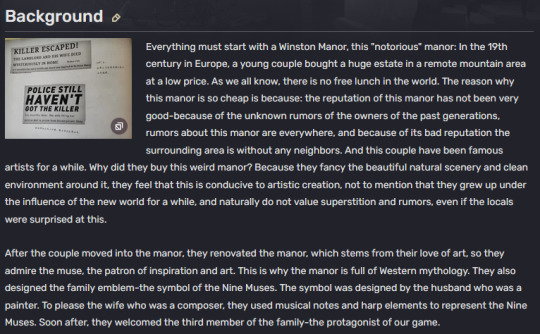
Not to mention the mountains and lakes, especially with the tallest and largest being in the area, connects to Oletus Manor, as we know it was “a huge estate in a remote mountain area”. Likely the same mountainous area that connects to Lakeside and its lake. And there are fish in lakes like Windermere, and combined with the sort of remoteness of Lake District, you could imagine it’d fit with a place like Lakeside Village, a poor fishing village.


Additionally, people were attracted to Lakeside Village due to a horror novel titled “Lakeside Trails”. After the works of Wordsworth and others, with the introduction of trains, many people started flocking to Lake District (so much so Wordsworth started complaining), and they similarly brought children here for vacations like is described in Hastur’s deductions (and rich built wealthy mansions here too, just like Oletus Manor).

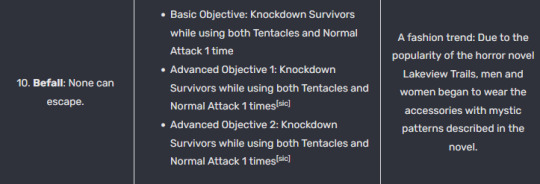

Then there’s how we know Golden Cave was at the foot of this mountain, and Cumbria does have mines, including Coal mines around Whitehaven dominated by the Lowther family (reminiscent of Count Barriere’s control of multiple areas) for a long period of time. There were even some disasters at a couple of these mines, including at Wellington Pit and Haig Pit (both after 1900 but still). On top of this, there has been some gold found in Lake District (such as at Dunmail Raise, Blencathra Mountains, Mungrisdale, Troutbeck, and Sedbergh), including in the streams in mountains just like Golden Cave’s backstory: “the once uninhabited barren mountain was rumored to have gold sand flowing in its streams”.

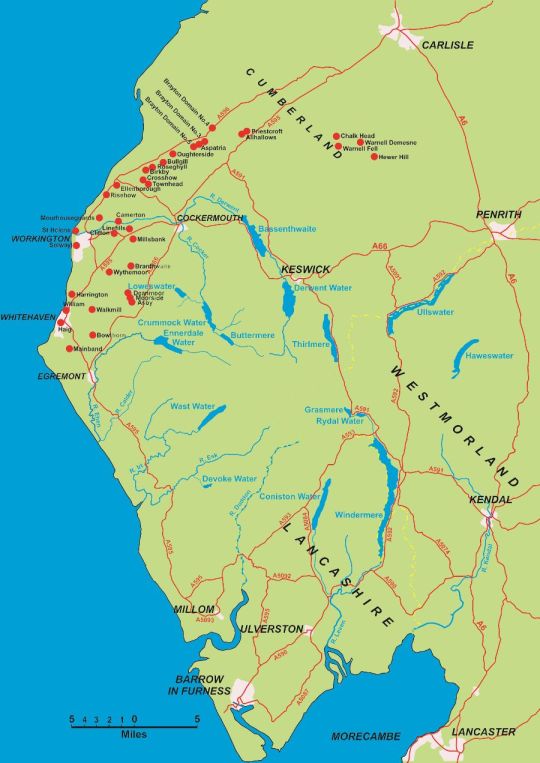


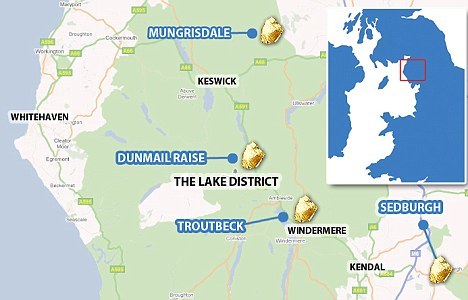
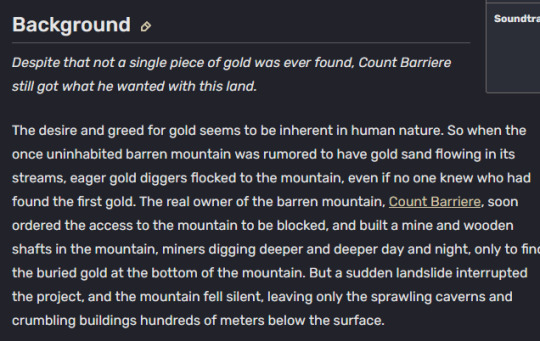
#idv#identity v#norton campbell#prospector#idv norton#identity v norton#idv prospector#identity v prospector#fool's gold#idv fool's gold#identity v fool's gold#hunter norton#idv hunter norton#identity v hunter norton#sirenjose analyses and theories
39 notes
·
View notes
Note
ana can you explain the liberal wars in simple terms? i visited algarve recently and the tour guide (like yours where it's mostly related to history) talked about the war between the brothers and a guy named remexido(?)
Just yesterday I told my boyfriend to please ask his coworker who graduated in history for a book on the civil war because thats the one thing I'm not good at lmao I didn't even know who Remexido was but apparently he was a guerrilla fighter from the Algarve which yay but fought on the side of Miguelistas which nay
The liberal wars was between Pedro IV of Portugal, better known as Pedro I fo Brazil, who was its first Emperor after declaring its independence, then to quote a brazilian client I had once, homeboy was a better king for the portuguese than he was an emperor for the brazilian... He basically stepped down and answered the plea from Portugal to come back here and kick his brother off the throne.
Now, his brother is Miguel I, the absolutist
Important background is that Portugal was an absolutist country thruoghout the 18th century, which means the king held absolute power. Think Louis the XIV level. Not only does the king have last say about everything government related, he works hand in hand with the church, who is below him (except the Inquisition) and he is celebrated as Godsend's. He is the centre of the universe. Its a time of extravagance, of theatricality, of excess, and the people, as you might imagine, are dirt poor.
This is essentially a kicker into the French Revolution, as you might imagine.
But with portugal, there's the Napoleon problem. Napoleon sends out General Junot to invade Portugal after successfully capturing spain, and on 1808 Junot arrives.
The Portuguese monarchy realised we did not have the arms to face off this guy, and the english, with whom we'd signed a treaty in 1387 and had always upheld it, said they were too busy fighting the french elsewhere... we needed to sort ourselves out. It was obvious by now that an invasion would be unstoppable. We did not have the navy nor the weapons to fight it off. So, the king, John VI, who by now is king because his mother, Maria I, went insane, decided to deceive Napoleon. He uprooted the government and took everyone to BRazil. He established court there and changed the name of his kingdom slightly to the kingdom of Portugal and brazil, it was something like that And then he made the capital city Rio de Janeiro. All in all he took with him about 100.000 people, nobility and court members as well as government. When Junot arrived, he was greeted by a Regency Government that basically said "step right in"
It was a way to show Junot that there was no government to overthrow and that he and his troops had been formally invited. Junot lived here until Napoleon told him to go pound sand somewhere else, and in the time he did, he fucked everyone's wife, lived in complete excess, and angered virtually everyone.
So, two more "invasions" happen, and by the third that's when Wellington and his beef come along to (this time, successfully) fend off the french.
And then, what happened was that this single event changed the country forever.
You'd be surprised to find how many in portuguese society were for Napoleon. Overall in Europe Napoleon was seen as the dude who was going to change the modern world, and it was actually accepted that he was undefeatable. When looking at the case of Portugal and Spain, most countries just went "submit bro there's no turning around". So it was a bit of a surprise that in the end backwards catholic portugal and the english won.
For example, the painter Vieira Portuense, arguably the most celebrated artists of portuguese neo-classicism and someone who met and hung out with Angelica Kauffmann, was so in favour of Napoleon not only was he arrested for it, he had to leave the country to escape persecution. There are paintings of him that originally had Napoleon's eagle hidden in it, but he had to repaint it to not offend anyone.
Basically, Napoleon offered a liberal alternative to the absolutist nightmare that was our country. Napoleon was the opposite of what Portugal was: a country ruled by a royal family who relished in absolute excess and also ruled by the church, and a country where the church held not just a monopoly on riches but controlled the country, so much so that the inquisition was still here despite the Marquis of Pombal's efforts to reduce its power. And a country that was mostly rural, ignorant, illiterate and extremely, painfully catholic. Liberals saw in Napoleon the chance to grow past this, embrace enlightenment, to evolve past catholic fervor.
These ideals, even long after Napoleon's death, will remain. Napoleon will influence the country enough that it will infect it with new liberal ideas and change the 19th century forever.
The absolutist monarchy stood against everything Napoleon defendedm because if those things were abolished, they would go to shit.
So when the french are kicked out, the english stay. General Beresford basically becomes a de facto king in the king's absence, because John VI turns out enjoyed the brazilian weather a lot more.
Now excuse me cause this is the part I'm not too familiar with. I was actually looking at a series of books by Laurentino Gomes on the topic. he's a brazilian historian who wrote about the portuguese court in brazil and slavery, so here's a tip for those like me who want to know where to start. What I'm not very familiar with is the court in brazil.
Basically, at a certain point, the king is forced to come back and get rid of General Beresford. The anti-british sentiment in the country that prevailed through the 19th century starts here, with Beresford benefitting a lot of his countrymen and repressing anyone who stands against him. THe book Felizmente Há Luar, which we had to study in school and is about the failed revolt by Gomes Freire, is about this exact fact.
There's a character here I haven't mentioned. Carlota Joaquina, wife of John VI, and arguably the vilest woman to have ever lived in this country. By "vile" I mean, spotting a hot guy on the way, finding out who he is, and having his wife killed so she can fuck him. It's downright insane. And Carlota Joaquina was the great manipulator behind her son, Miguel I.
WHile the royal family comes back to portugal, Pedro IV stays in Brazil. What led to the Ipirange scream is another thing I'm not familiar wiht but the presence of the royal family in Brazil reinforced the wish for independence. Maybe a brazillian follower can chime in and explain this a lot better (I'd actually REALLY appreciate that!!)
Pedro IV ends up declaring Brazil an Empire, this becoming Pedro I. I think it's shortly after that John VI, the man who hid chicken legs in his coat pockets out of fear of being poisoned, died by poison. Thus, his son Miguel gets to the throne
Now Liberal sentiment since Napoleon had grown considerably, and by now, Miguel is not happy, so he conducts a "purge". He leads a very repressive regime against Liberals, which lead them to contact Pedro in Brazil and ask him to come here and get rid of his brother.
I seriously don't know what leads to Pedro stepping down and his daughter Maria ascending to the throne (again, if another brazilian wants to either fact check me or teach me, I'm more than happy to hear), but Pedro comes to Portugal precisely to fight a war against his brother.
And that's the civil war.
Listen, in the middle of all of this, the root cause of the fight, is the Constitutional Charter. The Constitutional Charter had been approved in 1821, but barely upheld. I believe Miguel's mistake was to refuse the Constitutional Charter, as it was against absolutist ideals. Think of the constitutional charter as something like the 19th century Magna Carta, what limited a king's ability to jsut rule over everything and delegate the government to a parliament.
Another point of contention was the church. By now, the Inquistion is finally abolished (1820) but the church still holds IMMENSE power over the country. Liberals want something VERY CLOSE to a secular state. They want the people to have access to education outside of the church, and they want the extinction of monastic orders (which they will achieve in 1834). The absolutists can only exist with the church and its power, so Miguel is naturally against this.
Pedro IV ends up winning the war, and his brother is sentenced to exile and signs a contract stating his side of the family can never, ever take the throne. Fun fact: the "Duque of Braganza", the only remnant of the royal family we have today and who is at the head of the monarchist party, actually descends from Miguel. So you want to have an argument against him, just say "maybe your ancestor shouldn't have lost the war".
I don't know much about the liberal wars, but I know that, like the war againsat napoleon, it involved a lot of guerrilla. A notorious moment was the siege of Porto, in which Porto held strong agaisnt the absolutists (so, Miguel) so spectacularly (they even bombed Clérigos), Pedro IV left it in his will that his body should be buried in Brazil but his heart belonged to Porto. His heart is still there lmao
Again, if any brazilian reading this wants to add whatever, I'm more than happy to hear cause this is an episode of both our histories I am lacking in a lot
16 notes
·
View notes
Text

Hammond, William (Bill) - Wishbone Ash Stash, 2010.
Source: https://www.stuff.co.nz/the-press/entertainment/christchurch-arts/4209996/Bill-Hammonds-visionary-artworks

Hammond, William (Bill), Jingle Jangle Morning, 2006.
Source: https://www.aasd.com.au/artist/45-william-bill-hammond/works-in-past-sales/
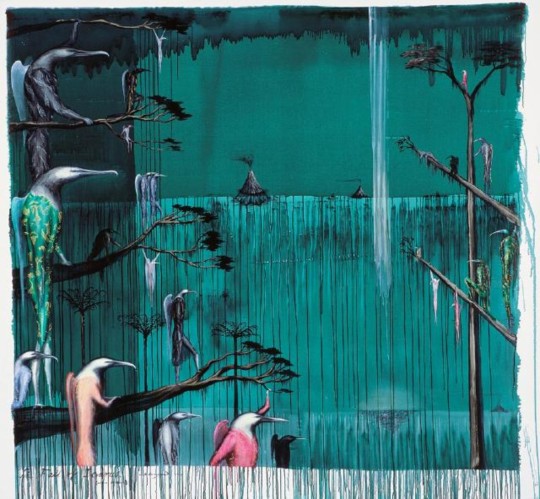
Bill Hammond - The Fall of Icarus, 1995, Acrylic on canvas. Collection of Christchurch Art Gallery, purchased, 1996. Reproduced with permission. Source: https://christchurchartgallery.org.nz/events/bill-hammond-the-fall-of-icarus-1995
Bill Hammond born William Hammond (29 August 1947 – 30 January 2021) was a New Zealand artist who was part of the Post-colonial Gothic movement at the end of the 1990s. He lived and worked in Lyttelton, New Zealand. The theme of his works centred around the environment and social justice.
Hammond was born in Christchurch on 29 August 1947. He attended Burnside High School. He went on to study at the Ilam School of Fine Arts of the University of Canterbury from 1966 until 1969. Before embarking on his career in art, he worked in a sign factory, made wooden toys, and was a jewellery designer. He also had a keen interest in music, serving as the percussionist for a jug band.
Hammond started to exhibit his works in 1980, and went back to painting on a full-time basis one year later. His first solo exhibition was at the Brooke Gifford Gallery in Christchurch in 1982. In March 1987 he showed for the first time at the Peter McLeavey Gallery in Wellington, an exhibition followed by over 20 others.
One of Hammond's best known work was the painting Waiting for Buller (1993). This was in reference to Walter Lawry Buller, the first New Zealander ornithologist who wrote A History of New Zealand Birds in 1873. Hammond was particularly interested in the contradictions in Buller's life, in how he documented birds while being a hunter and taxidermist. Another noted piece of his was Fall of Icarus (1995), which explores the effects of the colonisation on the country, and is exhibited at Christchurch Art Gallery. The Guardian described this as "his most famous work". His painting Bone Yard, Open Home (2009) was the largest single piece of canvas he painted, with a width of more than four metres.
The overarching theme of Hammond's work was social and environmental issues. Specifically, it touched on the imperiled state of both, as well as the destruction brought on by colonisation. His paintings feature two common themes: references to popular music and gaunt creatures with avian heads and human limbs. The characters in Hammond's paintings, which were often anthropomorphic animals, rarely move away from their natural habitat and are in no hurry. Humans are notably absent from his works during the later part of his career, which was influenced by his visit to the Auckland Islands in 1989. Two signature colors employed by Hammond were emerald green and gold. He was also at the forefront of the Post-colonial Gothic movement. This ultimately became "one of the most influential tendencies in New Zealand painting" at the turn of the 3rd millennium.
Hammond eschewed giving interviews and guarded his privacy. He died on the evening of 30 January 2021, at the age of 73. He was labelled as one of the country's "most influential contemporary painters" by Radio New Zealand.
https://en.wikipedia.org/wiki/Bill_Hammond
#bill hammond#new zealand artists#anthropomorphic animals#contemporary painters#avian#post colonial movement#birds
7 notes
·
View notes
Text
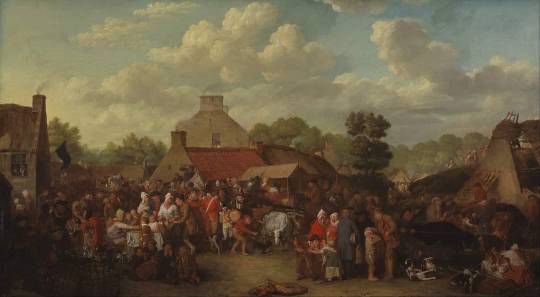


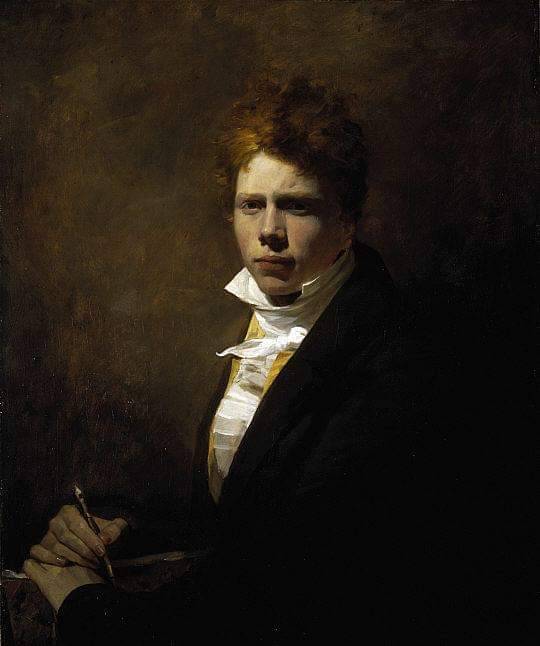
On November 18th 1785 Sir David Wilkie, the Scottish painter, was born.
Wilkie was born in Pitlessie Fife in Scotland on 18 November 1785. He was the son of the parish minister of Cults. He developed a love for art at an early age. In 1799, after he had attended school at Pitlessie, Kingskettle and Cupar, his father reluctantly agreed to his becoming a painter. Through the influence of the Earl of Leven Wilkie was admitted to the Trustees' Academy in Edinburgh, and began the study of art.
He is principally famous as the most popular genre painter of his time, but he also produced historical subjects and portraits. Wilkie moved to London in 1805 aged just 20, a year later an exhibition at The Royal Academy was a remarkable success for a painter so young.
His Chelsea Pensioners Reading the Gazette of the Battle of Waterloo (1822, Wellington Mus., London), commissioned by the Duke of Wellington, was so popular when shown at the Royal Academy that a rail had to be erected in front of it to protect it from the crowds. Between 1825–8 Wilkie travelled on the Continent for reasons of health (he had long been prone to nervous illness) and his work changed radically under the influence of Renaissance and Baroque painting, becoming weightier in subject matter and broader in touch.
Of his Scottish work I like his self portrait, (the first pic) thought to have been painted before leaving for London, Pitlessie Fair (seen in pic 2) and 'The Honours of Scotland'. The discovery of the Scottish Regalia (pic 3). The third one may look a bit rough, but it is the historical content embodied in the piece I like.
In 1840 he went to the Holy Land to research material for his biblical paintings and died at sea on the return journey; Turner (one of his many artist friends) commemorated him in Peace: Burial at Sea, as seen in pic 4.
16 notes
·
View notes
Text
The session of plenipotentiaries that never happened,
Or The tale of how I rediscovered that one lithography of Isabey’s famous painting in extremely high resolution and went through a total recall, so that everybody could suffer (myself including) ⭐️
The arrival of the Duke of Wellington had not only affected Vienna's diplomatic activity and social calendar; it was also posing a problem to the painter Jean-Baptiste Isabey, who was trying to capture the congress on canvas. He had been working for some time, and he had finally found a way to balance all the strong personalities, many of them patrons, into one single painting, and yet not offend national sensibilities or fragile egos.
The painting, which depicted the delegates gathered in a conference room, turned out to be a compromise in the best spirit of Vienna diplomacy.
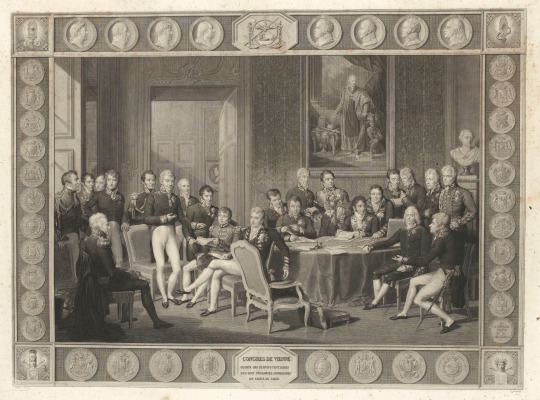
Metternich, the president of the Congress, draws the eye, as the only standing figure in the foreground.
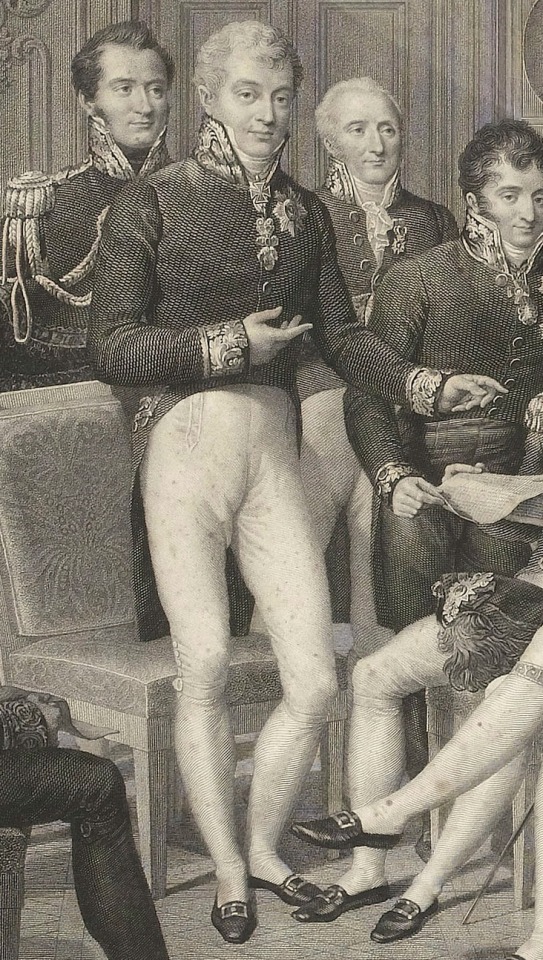
Castlereagh, though, commands the center, sitting with his legs gracefully crossed and elbow resting on the table.
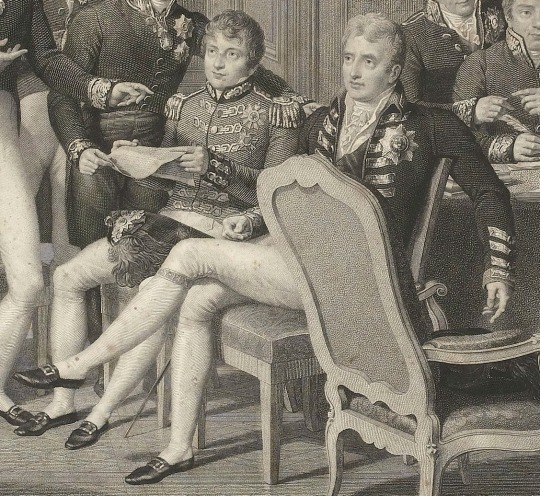
The light shining through the window, however, falls onto Talleyrand, sitting across the table with his dress sword at his side. An empty chair on both his right and left make him further stand out, as do the nearby figures who look to him, just as many of the smaller powers had sought his leadership the last few months.

As Isabey was putting the finishing touches to his composition, he had to figure out what to do about the fact that the Duke of Wellington was now also in town. Starting over was out of the question. Omitting a man of his stature was equally impossible. Yet it was not easy to incorporate him into a canvas on which all the best places had already been taken. The painter's solution was simple and elegant: why not make the painting commemorate the Duke of Wellington's arrival in Vienna?
That way, the duke could simply be inserted on the far left side of the painting, without any insult to his position. As for the duke's reluctance to be painted from a side angle (he was self-conscious about his nose), Isabey had overcome that with a well-targeted compliment: didn't Wellington look like the handsome and chivalric Henry IV? Pleased with this comparison, Wellington accepted, joking that Isabey was a "good enough diplomat to take part in the Congress".
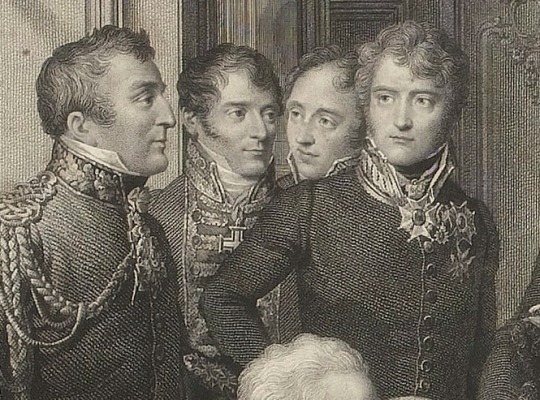
The painter also had to apply his finesse to convince Humboldt to enter the studio. The Prussian ambassador hated to have his portrait made, and, sure enough, he first declined, claiming that he had "too ugly a face ever to spend a penny" on a portrait. With this statement, Isabey saw his opportunity and emphasized that he would not "ask the slightest recompense for the pleasant trouble I am going to take". Isabey only wanted "the favor of a few sittings".
"Oh, is that all?" Humboldt quickly came around when he realized it would not cost him anything. "You can have as many sittings as you like".
Later, many congratulated Isabey on his portrait, particularly the fine job with Humboldt. The Prussian did not pay anything, as agreed, and Isabey got his revenge, Humboldt joked, by painting "an excellent likeness of me".
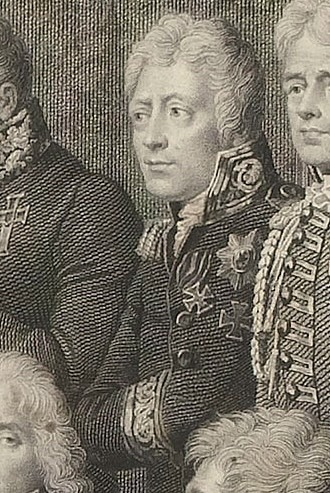
Few could complain of the treatment received from Isabey's flattering brush. This famous painting of the Congress of Vienna was pleasing to all, though typical of this peace conference, the scene was purely imaginary. The group of twenty-three delegates had never met in exactly this way before. Isabey had painted the portraits of each figure individually, and then later assembled the whole group together.
And so, symbolically, this simulated image would commemorate a congress that never was.
After that spectacular depiction of historical context surrounding Isabey’s magnificent canvas by David King few things are left to be added. I would simply love to highlight some other figures of utmost importance for the diplomatic life of that illustrious historical period - there are
Karl August von Hardenberg, Prime Minister of Prussia at the time;
Herren Wacken and Friedrich von Gentz, two Secretaries who were responsible for the protocols of the most important Congress' meetings;
count Karl Vasilyevich Nesselrode, a Russian-German diplomat, who was going to become state chancellor of the Russian Empire (in 1816);
prince Andrey (Andrew) Kirillovich Razumovsky, an extremely wealthy Russian aristocrat and diplomat, for whom Vienna was like his second home;
and we shouldn’t (or rather can’t) forget about general Charles Stewart-Vane, Castlereagh’s younger brother who definitely knew how to throw an unforgettable party, so refined aristocratic society could discuss his wild adventures at their fashionable salon meetings day and night. ✨


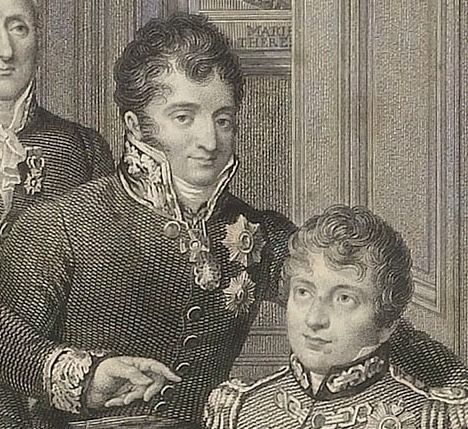
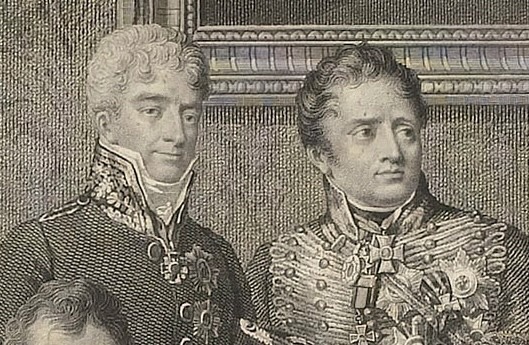
P.S.
Perhaps, there should be more posts with other details of the lithograph as well as Isabey’s original canvas, I’ll just need some time and motivation for that. 👌
#I bet some people know perfectly well what was playing in the background during the arrangement of this post ����#the congress of vienna#klemens von metternich#metternich#robert stewart#lord castlereagh#charles-maurice de talleyrand-périgord#talleyrand#wilhelm von humboldt#humboldt#hardenberg#friedrich von gentz#nesselrode#prince razumovsky#charles stewart-vane#napoleonic era#napoleonic wars#19th century#1814#1815
45 notes
·
View notes
Text
Great news for the Boromir fandom!
I went to the Weta Cave in Wellington - an INCREDIBLE experience I highly recommend to anyone who has seen films.
One of the miniature painters rebranded a discarded set of toys to make a band, but I couldn't take pictures of it so I'll do my best to describe it.
Tessa Thompson's 'Molly' in Men in Black had the tambourine
The messenger goblin in An Unexpected Journey had a small drumkit
Gollum had a rainbow mohawk and a full drumkit
Boromir was the main singer, complete with full purple glittery jacket and black hair and beard to match
@esta-elavaris @sotwk @ass-deep-in-demons thought you'd like to know 😘
11 notes
·
View notes
Text
#paint#painters#painting contractor#wellington#painting service#painting service wellington#wellington painters#house painter#building painters wellington#wellington painting contractor
0 notes
Text
Expert Painting Services in Wellington: Why Choose ZR Decorating Services

When it comes to giving your home or office a fresh new look, choosing the right painter can make all the difference. ZR Decorating Services stands out as a premier choice in Wellington for professional painting services. Our team of experienced painters is dedicated to providing top-notch quality and exceptional customer service, ensuring your painting project is seamless and stress-free.
Unmatched Professionalism:
At ZR Decorating Services, professionalism is at the core of everything we do. From the initial consultation to the final inspection, our team ensures every detail is covered. We understand that inviting painters into your space requires trust. Therefore, our professionals are not only skilled in their craft but also respectful of your property, ensuring minimal disruption and leaving your space clean after the job is done.
High-Quality Materials:
We believe in using only the best materials for our projects. ZR Decorating Services partners with leading manufacturers to source premium paints and supplies. This commitment to quality means that the colors are vibrant, finishes are durable, and your walls look great for years to come. Whether it’s a glossy finish for your office or a soothing matte for your bedroom, we have the right solutions to match your style.
Customized Solutions:
Every space is unique, and so are your painting needs. We offer customized painting solutions tailored to meet the specific requirements of your project. Whether you need exterior painting to withstand Wellington’s variable weather or interior painting to complement your home décor, our experts provide personalized advice and services that align with your aesthetic and functional needs.
Comprehensive Services:
ZR Decorating Services is your one-stop-shop for all painting needs. Our services extend beyond mere wall painting. We offer a variety of decorative techniques, including wallpaper installation, special finishes, and wood staining. Our team is equipped to handle projects of all sizes, from small residential rooms to large commercial buildings, ensuring consistency and quality across all services.
Exceptional Customer Service:
Our commitment to customer satisfaction sets us apart. We understand that your time is valuable, which is why we ensure timely completion of projects without compromising on quality. Our transparent pricing policy means no hidden costs, and our free, no-obligation quotes help you plan your project with clarity. Our team is always available to answer your questions and provide updates throughout the project duration.
Proven Track Record:
With years of experience serving the Wellington community, ZR Decorating Services has built a reputation for excellence. Our portfolio includes a wide range of projects, from residential homes to commercial spaces, each completed with the highest standards of craftsmanship. Client testimonials and repeat business are a testament to our ability to deliver outstanding results.
Sustainability Practices:
In today’s world, environmental responsibility is crucial. We adopt eco-friendly practices in our projects, including using environmentally safe paints and ensuring proper disposal of materials. Our aim is not only to beautify spaces but also to preserve our environment for future generations.
Conclusion:
Choosing the right painter is crucial for achieving the desired outcome for your space. ZR Decorating Services offers a blend of experience, quality, and customer-focused services, making us the best choice for anyone looking for painters in Wellington. Our team is ready to transform your vision into reality with professionalism and skill. Contact us today to discuss your next project and see why we are the preferred choice for painting services in Wellington.
Call to Action:
Ready to give your space a new look? Contact ZR Decorating Services at [insert contact information] for a free quote and consultation. Let us help you bring your vision to life with expertise and elegance.

1 note
·
View note
Text
Commercial Painter in Wellington
Transform your Wellington commercial space with Viet Duc Ltd, the experts in enhancing business environments. Our commercial painters in Wellington understand the art of creating an atmosphere that leaves a lasting impression. With meticulous attention to detail and a flair for design, we go beyond paint to craft a setting that aligns perfectly with your brand. Elevate your workspace with Viet Duc Ltd and watch your business thrive in a visually inspiring environment.
0 notes
Text
Books I Am Currently Reading
The Curious Incident of the Dog in the Night-Time (Mark Haddon)
The Picture of Dorian Gray (Oscar Wilde)
Tex (S.E. Hinton)
This book tells the story of a 15-year-old boy named Christopher Boone who discovers his neighbour's black poodle, Wellington, dead in her backyard. Wellington was murdered with a gardening fork, and Christopher is determined to find out who committed the murder.
This book is about a painter named Basil Hallward, who paints a portrait of his friend, Dorian Gray. Dorian Gray meets a man named Lord Henry, and feels the need to sell his soul in exchange for staying young forever, making the painting age rather than him.
This book revolves around a boy named Texas who loves horses and lives with his older brother, Mason. His mother passed away, and his father leaves for extended periods of time, leaving the boys to struggle with money. One day, Tex finds out that his horse was sold, which adds on to all the other things going wrong in his life, but he learns that even though you can't stop things from changing, you don't have to let it change you.
#books and reading#the curious incident of the dog in the night time#the picture of dorian gray#tex#se hinton
3 notes
·
View notes
Text
Summary: nothing important, just my personal opinion on the symbolism of eyes, accessories and the Moon in Ikevamp
Warnings: minor spoilers for all routes, mild spoilers for Shakespeare and Faust
I just want to say that Ikevamp is probably one of the best otome games in terms of character design. So many tiny details, and the more you read, the more hints you actually find.
Let's take, for example, Shakespeare. The Act 1 suggests that the Bard of Avon is the main villain of the story. He knows about the revival of the Duke of Wellington and Antonio Salieri, plays a major role in Vincent and MC’s separation, helps Gauguin to bring Theo to the cliff where they play cops and robbers and just acts suspicious in Leo’s route. Many routes include this chapter where Comte rushes to Will’s private villa and asks whether he is behind the drama with historical figures being brought back to life.
However, Act 2 slowly but gradually dents our confidence. Here we get a chance to meet with the mysterious ‘shade’ in church and find out that during all this time Will has been a double agent. As the story unfolds, Shakespeare’s portrayal also begins to change, especially in terms of his attitude towards Vlad’s ambitions and methods used to achieve them. William from Act 1 acts like a mad genius who is in desperate need of a tragedy that can move everyone's heart, and he won’t hesitate to do everything he can to create his masterpiece. But Will in Act 2 reveals the duality of his soul, showing us that behind that mask of evil goodness there is room for fears, questions doubting the fundamentals of his lord’s moral views and actions Will has to perform himself as his agent on the way to building ‘a perfect future’. In Jean’s route, for example, William is genuinely frightened with Vlad using his power to control Gilles de Rais’s mind, driving the former solder to the point of madness, and Dazai’s route proves that this feeling of pure horror further leads to triggering Will’s psychological trauma as he receives the greater vampire’s ‘gift’. Shakespeare’s own route puts an end to Will’s moral searches, giving an answer regarding what side the writer chooses to be on.
The looks and costumes help us to follow the character’s story. The most catching part of Will’s appearance seems to be his famous heterochromia, the symbolism of which has been probably discussed earlier, so I'll point at the key moments. The bard’s right eye is the color of gold while his left eye is crimson red. And for a good reason.

The red color is considered to be polysemantic. In some cultures it is used to describe love, energy and the welcoming heat of fire, in others — it stands for blood which reminds of wars, danger and violence. There is, however, one thing that unites all these feelings, and it is called passion. Passion can give us energy and strength to move forward, but it can also blind us with anger and jealousy.
Shakespeare is blind both physically and metaphorically. His red eye is blurry with blood as a result of a childhood’s disease, thus he can’t see anything with it. At the same time, William’s mind is obnubilated with the fear of being not good enough — which is basically the main symptom of the impostor syndrome, hence his desire to write the best tragedy possible in order to prove everyone, himself included, that he does have the talent many praise him for.
The other eye is golden. Here my guess is that this color is mentioned as the opposite to the darkness caused by William’s half-blindness. Golden is another word for ‘light’ desired by Shakespeare’s kind side. This bright side of him makes Shakespeare cherish and enjoy his friendship with Vincent (though it still doesn't prevent him from using the painter as the main source of information coming from the mansion). This kindness dictates Will to help MC when she is attacked by those bastards in the first chapters of his own route. And this very gentleness of his heart is a driving force for his inner protest to Vlad’s wish to kidnap MC in Comte’s route. As you remember, Shakespeare obeyed his lord’s command only under the brainwashing spells and later expressed sincere regrets regarding not being able to stop the pureblood.
The combination of good and evil, red and golden is an allusion to William's connection with both Vlad (whose eyes resemble crimson moon) and Comte (in the prologue MC describes his gaze as ‘spun gold’).
Why do I mention the character’s costume at the beginning? Because it enables us to answer what side Will is on even without reading his story.
If we look at the attire of the Evil Trio, we can actually see that everyone wears a small crescent moon shaped brooch — a particular sign of belonging to their secret community.



William doesn't have one.
🌙
This is where I was originally planning to stop. In spite of it, I got really interested in the meaning behind those brooches, so I decided to delve a little bit deeper. Again, these are only my own speculations. Probably, Vlad’s route contains the explanation, and I'm dumb. But I haven’t read it yet, so let’s continue.
In general, we can analyze the symbolism behind the crescent moon in two different ways, relying on our knowledge of either mythology or heraldry.
The crescent symbol has been used in various legends as a divine attribute. In Ancient Greek and Roman mythology the crescent moon is said to represent Selene/Luna, lunar goddess, and some stories suggest that the curves of the crescent shape remind the bow used by Diana, the goddess of hunt. In ancient Egypt people honored the moon god Khonsu whose name can be translated as ‘a traveler’ — a pretty interesting coincidence, considering Vlad’s abilities to travel through times and spaces as an immortal vampire and by using the door. Thus, the crescent shaped brooch may point at the pureblood’s divine origins, explaining on of the reasons why other immortals call him ‘the son of God’.
On the other hand, the brooch can be a reference to Vlad’s homeland.
This picture illustrates the coat-of-arms of the Hunyadi family from which, according to some historians, comes the coat-of-arms of Wallachia, the region ruled by the House of Draculesti. A black raven is depicted in the center with a ring in its beak. Later on, the Hunyadi coat-of-arms was added with the image of the crescent in the top right.

This tradition was further fixed during the reign of Mircea I, the grandfather of Vlad the Impaler, though it slightly differed from the original image as we can see the cross occurring in the central part of Mircea’s seal.

The same image was on the seal of Radu IV, Vlad’s nephew, with the moon replaced to the left.
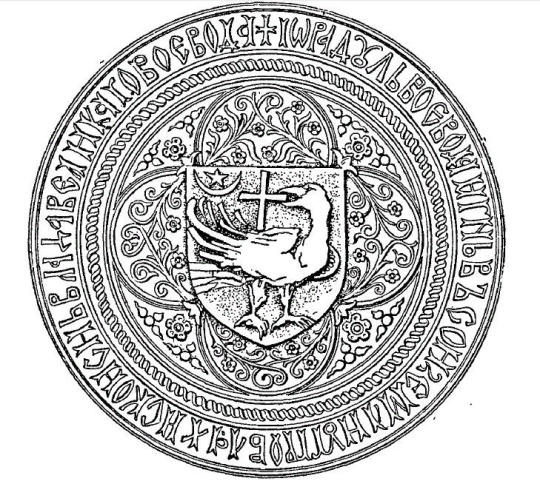
Not only that, during the period when Vlad was the Voivode of Wallachia he ordered to mint new trade coins. Up until today only two such coins were described in Romanian numismatic papers. This is one of them with the image of Vlad’s coat-of-arms inside the inner linear circle. Inside the first field there is a waxing half moon and a six ray star below it.

Curious as it is, if we overlay the shapes of a moon and a cross one another, we’ll get the image most close to the original version of the Trio’s brooch.
Nevertheless, I wouldn't dismiss the third idea that the crescent brooch represents fate that brought everyone together in the XIX century.

To begin with, the moon plays several roles in the game. Visibly, it acts as a mirror reflecting MC’s feelings and inner thoughts. The prologue shows how much she is frightened of the sudden changes in her life and the prospect of not being able to go back home. XIXth century France is dangerous, and this specific view of the world is emphasized with the nature descriptions. That's why in Arthur’s route the crescent moon is written as a ‘gibbering madman’s smile in the dark sky’, in Vincent's route — as a ‘mocking grin’ fueling MC’s anxiety.
The Moon in Ikevamp universe, however, is often described as a silent embodiment of fate, the theme of which runs through the story like a golden thread. The crescent moon takes the role of a powerful force, guiding MC through the door (in Isaac’s route MC even asks herself, 'Had that moon guided me? Was I under its sway?'), dominating behind the walls of the Musee du Louvre (in Leonardo’s route MC thinks, ‘I wound up in an eventime world ruled by a crescent moon’).
The epilogues of some of the stories contain the scene where MC is shown to enjoy the view of the sky and remembers how the same crescent she saw on her very first night in the mansion was a harbinger of a major turning point in her life. A very clever choice of structuring writing as it allows to logically loop the plot.
🌗
This is where I need to stop, but I want to say just a few more words about two other members of the Trio. Faust and Charles. What does the crescent mean for them?
Now, I’m not a huge fan of searching for a black cat in a dark room, especially if there is no one there. This is the exact reason why I had to abandon the theory about the link between the brooch and Charles's past as an executioner. It's too far-fetched whereas we have a far more satisfying answer. Wearing the brooch, Faust and Charles show loyalty to their sire. At least, in the case of Charles it does seem true, taking into account his obsession with Vlad.
But with Faust it's a bit more complicated.
The central conflict in his route is called 'man against self' or, more precisely, a priest searching for and finding the lost faith. These searches stem from a plethora of moral dilemmas such as the right of a man wearing a cross to rebel against God watching the injustice of the world; the existence of so-called ‘fair sacrifice’ when in order to save hundreds of lives you have to kill one or vice versa.
Faust himself is portrayed as a ridiculously cynical and unprincipled man who doesn't scorn to experiment on corps and sincerely despises any sign of human weaknesses. At the same time, this very man is the one who supplements the citizens with the medicine without taking any money, spends his free time with orphans and despite looking genuinely annoyed cares about their well-being, knowing too well what it's like to be deprived of love and compassion. He’s given up on merciful Heaven because he’s never been a subject of mercy. Still, everyday he goes to church and listens to confessions of his parishioners.
I don't want to spoil other details of his route, but I think it's of particular importance to discuss MC’s words she tells him in the final chapters. As I understand, their meaning is somehow close to
‘your hands are what give others hope’
This is such a beautiful and touching way of saying that despite Faust telling her multiple times that he sees no hope in the future, in reality he carries it deep inside his heart. Otherwise, he wouldn't see the point in being revived as a vampire and rebelling the very principles of the world’s existence, he wouldn't listen and give a helping hand to the praying people in church, knowing a common belief that a person can to speak to God via priests as his voice on Earth.
No matter how hard the obstacles were, how painful and lonely he felt, Faust never wanted to lose hope and faith in his abilities to change his destiny by creating a world where everyone’s prayer can be heard.
How on Earth is the crescent moon involved here?
At this moment you should know I am a myth nerd.
The crescent was associated with goddess Hekate in the Roman Time Period and in Late Antiquity. While she wasn't originally a lunar goddess and a part of the Pantheon, Hekate was still known as the deity of dark magic, medicine and necromancy. Faust, as mentioned before, is attracted to alchemy, pharmaceutical and paranormal studies as well as experiments on the dead. According to the legend, he also used to practice witchcraft.
Alongside with that, Hekate had an important mission of guiding the lost souls. A crescent, her attribute, was incorporated in many poems and writings as a metaphor for hope that the moonlight gives to travelers as they try to see the road in the darkness of the night.
So, Faust’s crescent shaped brooch in the game may be another way of proving that in spite of all his bravada and claimed indifference, the truth is he always wears hope on his chest, though he can't see it as he doesn't listen to his heart (that's why the brooch is on the right and not on the left).
Hope drives him forward, makes him use everything he can —knowledge, experience, will — to create a brighter future. Hope creates aspiration, and aspiration nourishes hope. In fact, this is what brings Ikevamp Faust close to Goethe's character.
In Part I Scene I: Night there is a marvelous monologue of Faust addressing the moon.
‘O, may you look, full moon that shines,
On my pain for this last time:
So many midnights from my desk,
I have seen you, keeping watch:
When over my books and paper,
Saddest friend, you appear!’
He wishes to leave the material world he lives in in order to achieve his greatest goal — to learn the irreversible laws of the universe. As he speaks, the moon becomes something more than a lifeless object, it represents his aspiration, distant and difficult, almost impossible.
‘… And need you ask why my heart
Makes such tremors in my breast?
Why all my life-energies are
Choked by some unknown distress?’
#ikemen series#ikemen vampire#ikevamp#ikevamp shakespeare#ikevam vlad#ikevam arthur#ikevam leonardo#ikevamp theo#ikevamp faust#ikevamp charles#ikevamp comte#ikevamp dazai#ikevamp jean#ikevamp vincent#ikevamp napoleon
49 notes
·
View notes
Photo
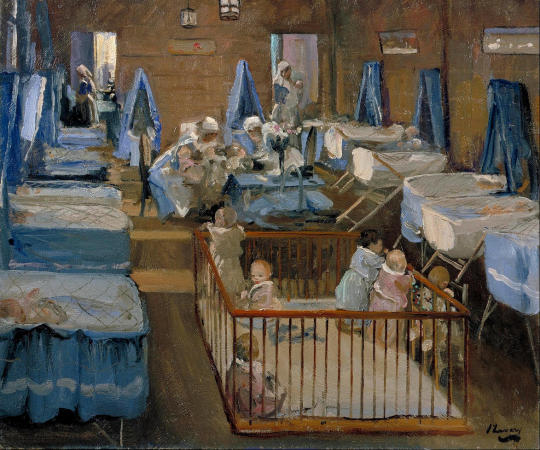
MWW Artist of the Day (5/23/23)
John Lavery (Irish, 1856–1941)
Lady Henry's Crêche, Woolwich (1919)
Oil on canvas, 63.5 x 76.2 cm.
Imperial War Museum, London
Lady Henry -- Julia -- was the wife of Sir Charles Solomon Henry, Liberal MP for Wellington in Shropshire. Lady Henry probably funded some of the costs for the building and running of the nursery herself together with a subsidy from the Ministry of Munitions. The Nursery opened in May 1917 and closed March 1920 when Lady Henry presented it to to the London County Council in memory of her only son who was killed during the War. Lavery, a successful society painter, was over military age and prevented from joining the Artists’ Rifles, despite successive attempts. He was appointed an official war artist in 1917, but following a car crash in London, he remained in Britain, painting home subjects.
7 notes
·
View notes